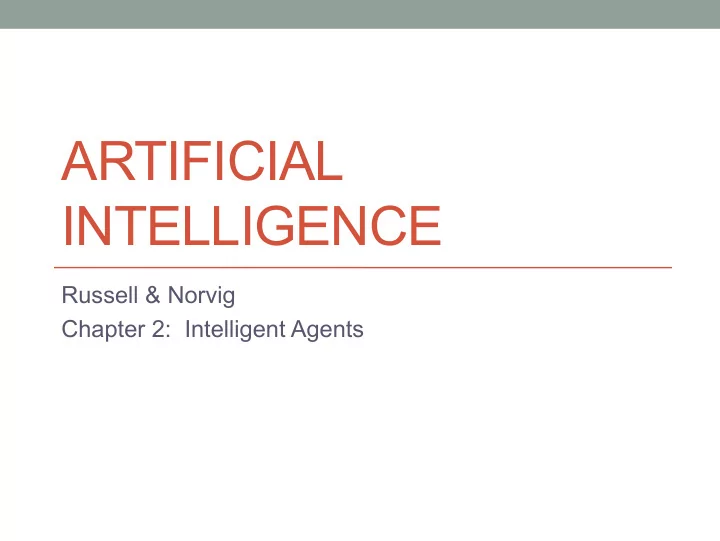

ARTIFICIAL INTELLIGENCE Russell & Norvig Chapter 2: Intelligent Agents
Agents • “An agent is anything that can be viewed as perceiving its environment through sensors and acting upon that environment through actuators.”
Percepts • Percepts are the agent’s “perceptual inputs” at any instance. • The Percept History is the complete sequence of everything the agent has perceived. • An agent’s choice of action at any given instant can depend on the entire percept sequence observed to date, but not anything it hasn’t perceived. • Agent function maps from percept history to actions
Vacuum cleaner world example • Percepts: location and contents, e.g., [A,Dirty] • Actions: Left , Right , Suck , NoOp
A vacuum-cleaner agent
Rationality • A rational agent is one that does the right thing. • Every entry in the table is filled out correctly. • What is the right thing? • Approximation: the most successful agent. • Measure of success? • Performance measure should be objective • E.g. the amount of dirt cleaned within a certain time. • E.g. how clean the floor is. • … • Performance measure according to what is wanted in the environment instead of how the agents should behave.
Rational Agent • What is rational depends on: • The performance measure that defines the criterion of success • The agent’s prior knowledge of the environment • The actions that the agent can perform • The agent’s percept sequence to date • Definition of a rational agent: For each possible percept sequence, a rational agent should select an action that is expected to maximize its performance measure, given the evidence provided by the percept sequence and whatever built-in knowledge the agent has.
More rationality! Rationality ≠ omniscience • An omniscient agent knows the actual outcome of its • actions. Rationality ≠ perfection • Rationality maximizes expected performance, while • perfection maximizes actual performance. Components required for rationality • Exploration (information gathering) • Learning (go beyond apriori knowledge) • Autonomy (independent of prior knowledge) •
Environments • To design a rational agent we must specify its task environment • PEAS description of the environment: • Performance • Environment • Actuators • Sensors
Automated Taxi Driver Example • PEAS Environment: • Performance measure : Safe, fast, legal, comfortable trip, maximize profits • Environment : Roads, other traffic, pedestrians, customers • Actuators : Steering wheel, accelerator, brake, signal, horn, display • Sensors : Cameras, sonar, speedometer, GPS, odometer, engine sensors, keyboard
Agent: Medical diagnosis system Performance Measure Healthy patient, reduced cost Environment Patient, hospital staff Actuators Display of questions, tests, diagnoses, treatments, referrals Sensors Keyboard entry of symptoms, findings, patient’s answers
Agent: Part-picking robot Performance Measure Percentage of parts in correct bins Environment Conveyor belt with parts, bins Actuators Jointed arm and hand Sensors Camera, joint angle sensors
Environment Types • Fully observable (vs. partially observable): An agent's sensors give it access to the complete state of the environment at each point in time. • Deterministic (vs. stochastic): The next state of the environment is completely determined by the current state and the action executed by the agent. (If the environment is deterministic except for the actions of other agents, then the environment is strategic ) • Episodic (vs. sequential): The agent's experience is divided into atomic "episodes" (each episode consists of the agent perceiving and then performing a single action), and the choice of action in each episode depends only on the episode itself.
Environment types, continued • Static (vs. dynamic): The environment is unchanged while an agent is deliberating. (The environment is semidynamic if the environment itself does not change with the passage of time but the agent's performance score does) • Discrete (vs. continuous): A limited number of distinct, clearly defined percepts and actions.
Example task environments Crossword Chess Poker Back- Taxi Medical puzzle w/ gammon driving Diagnosis clock Observable Fully Fully Partial Fully Partial Partial Agents Single Multi Multi Multi Multi Single Deterministic Determ Determ Stoch Stoch Stoch Stoch Episodic Seq Seq Seq Seq Seq Seq Static Static Semi Static Static Dyn Dyn Discrete Disc Disc Disc Disc Cont Cont
Simple vs. Real Environments • The simplest environment is • Fully observable, deterministic, episodic, static, discrete and single-agent • Most real situations are: • Partially observable, stochastic, sequential, dynamic, continuous and multi-agent
Recommend
More recommend